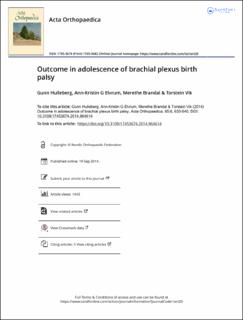| dc.contributor.author | Hulleberg, Gunn | |
| dc.contributor.author | Elvrum, Ann-Kristin | |
| dc.contributor.author | Brandal, Merethe | |
| dc.contributor.author | Vik, Torstein | |
| dc.date.accessioned | 2021-08-25T13:35:00Z | |
| dc.date.available | 2021-08-25T13:35:00Z | |
| dc.date.created | 2014-11-17T09:34:31Z | |
| dc.date.issued | 2014 | |
| dc.identifier.citation | Acta Orthopaedica. 2014, 85 (6), 633-640. | en_US |
| dc.identifier.issn | 1745-3674 | |
| dc.identifier.uri | https://hdl.handle.net/11250/2771237 | |
| dc.description.abstract | Background and purpose — The frequency and severity of a permanent lesion after brachial plexus birth palsy (BPBP) and its impact on activities of daily living are not well documented. We therefore investigated the outcome of BPBP in adolescents, regarding arm function and consequences for activity and participation.
Participants and methods — Of 30,574 babies born at St. Olavs University Hospital in 1991–2000, 91 had BPBP (prevalence 3 per 1,000), and 69 of these individuals were examined at a median age of 14 (10–20) years. The examination included the modified Mallet classification, range of motion, shoulder rotation and grip strength, Assisting Hand Assessment, and Canadian Occupational Performance Measure. Of the 22 subjects who were not examined, 3 could not be traced and 19 reported having no problems in the affected arm.
Results — At follow-up, 17 adolescents had a permanent lesion (i.e. individual Mallet subscore below 4) with a median Mallet total score of 15 (9–19), while 52 had good or normal shoulder function (median Mallet total score 25 (23–25)). All participants with a permanent lesion had reduced active shoulder rotation (≤ 15°), 16 had elbow extension deficit, and 10 had subnormal grip strength. External rotation was considerably weaker in the affected shoulder. In addition, they had ineffective use of the affected arm in bimanual activities. Even so, all except 1 were independent in activities of daily living, although 15 experienced minor difficulties.
Interpretation — Every fourth to fifth child with BPBP had a permanent lesion as an adolescent. External rotation was the most impaired movement. Despite ineffective use of the affected arm in bimanual activities, all of the participants except one were independent in activities of daily living. | en_US |
| dc.language.iso | eng | en_US |
| dc.publisher | Taylor & Francis | en_US |
| dc.rights | Attribution-NonCommercial-NoDerivatives 4.0 Internasjonal | * |
| dc.rights.uri | http://creativecommons.org/licenses/by-nc-nd/4.0/deed.no | * |
| dc.title | Outcome in adolescence of brachial plexus birth palsy - 69 individuals re-examined after 10-20 years | en_US |
| dc.type | Peer reviewed | en_US |
| dc.type | Journal article | en_US |
| dc.description.version | publishedVersion | en_US |
| dc.source.pagenumber | 633-640 | en_US |
| dc.source.volume | 85 | en_US |
| dc.source.journal | Acta Orthopaedica | en_US |
| dc.source.issue | 6 | en_US |
| dc.identifier.doi | 10.3109/17453674.2014.964614 | |
| dc.identifier.cristin | 1173465 | |
| dc.description.localcode | © Nordic Orthopaedic Federation. This is an open-access article distributed under the terms of the CC-BY-NC-ND 3.0 License which permits users to download and share the article for non-commercial purposes, so long as the article is reproduced in the whole without changes, and provided the original source is credited. | en_US |
| cristin.unitcode | 1920,9,0,0 | |
| cristin.unitcode | 1920,7,0,0 | |
| cristin.unitcode | 194,65,15,0 | |
| cristin.unitcode | 1920,5,0,0 | |
| cristin.unitname | Klinikk for ortopedi, revmatologi og hudsykdommer | |
| cristin.unitname | Klinikk for kliniske servicefunksjoner | |
| cristin.unitname | Institutt for klinisk og molekylær medisin | |
| cristin.unitname | Klinikk for fysikalsk medisin og rehabilitering | |
| cristin.ispublished | true | |
| cristin.fulltext | original | |
| cristin.qualitycode | 1 | |

